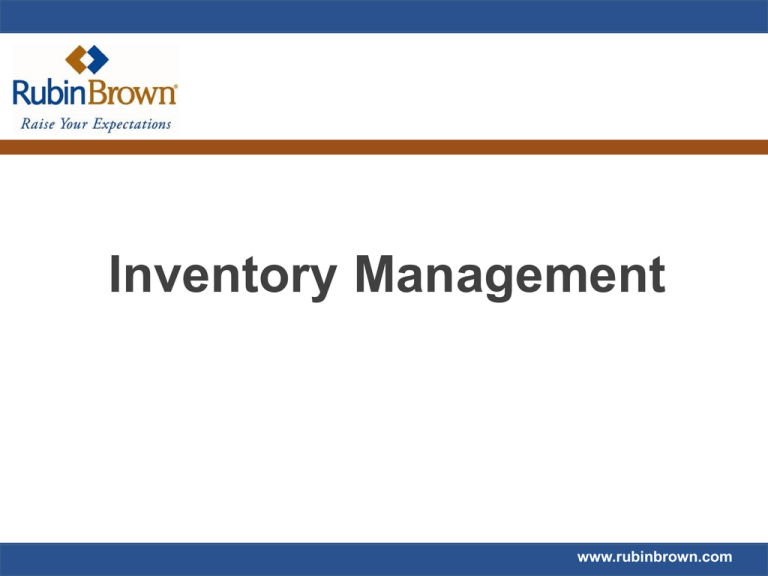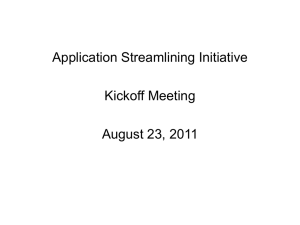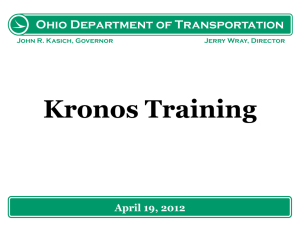Cycle Counting Program – Methodology
advertisement

Inventory Management www.rubinbrown.com Agenda Effective Inventory Management Strategic Considerations Supply Chain Management Purchasing and Production Sales and Customer Service Suppliers and Customers Inventory Accuracy Cycle Count Strategies 2 Competing Objectives…. Sales/Marketing/Customer Service Objective Maintain sufficient on hand inventory to satisfy every possible (or impossible) customer request Production Objective Maintain on hand inventory quantities that produces the lowest cost per unit Inventory Management Objective Maintain lowest level of on hand inventory to satisfy customer demand while minimizing cost 3 ….Producing Different Results Sales/Marketing/Customer Service Objective Maintain sufficient on hand inventory to satisfy every possible (or impossible) customer request Results in on hand inventory for every SKU available in large quantities consuming a large amount of space Production Objective Maintain on hand inventory quantities that produces the lowest cost per unit Results in maintaining large quantities of low cost SKU’s on hand but not specialty/unique SKU’s that customers demand Inventory Management Objective Maintain lowest level of on hand inventory to satisfy customer demand while minimizing cost Results in maintaining appropriate amounts of each SKU on hand to ensure customer demands are adequately met 4 Cost of Excess Inventory Carrying Cost $5,000,000 x 6% interest cost = $300,000 carrying cost Hidden Costs Warehousing and Rent Labor Costs (moving, counting, maintaining) Cash flow considerations Quality 5 Inventory Management Sales Forecast Customer Communications Production Inventory Management Warehouse Purchasing Supplier Communications 6 Inventory Management Sales Forecast Customer Communications Inventory ???????? Production Warehouse Purchasing Supplier Communications 7 Traditional Inventory Tools Economic Order Quantities (EOQ) Vendor Managed Inventory Slow Moving Inventory Reports Cycle Counting 8 Purchasing and Production Purchase and manufacture based on customer demand – NOT BASED ON VOLUME DISCOUNTS OR UNIT COST CONSIDERATIONS Map the purchasing and production processes identifying non-value added activities, bottlenecks, constraints, etc. Strengthen your Preventive Maintenance program Results in more reliable production and quality Maintain discipline in the Engineering group BOM accuracy Engineering changes 9 Sales, Marketing, and Customer Service Map the sales forecasting and sales order processes identifying non-value added activities, bottlenecks and constraints Commit to SKU Rationalization using historical data with up-front sales team involvement Compensation plans should be built around selling profitable SKU’s 10 Suppliers and Customers Suppliers Reduced lead times Quality inspections prior to shipment Shipment accuracy Customers Cooperative forecasting On-line, real time order to shipment tracking 11 Accounting and Finance What can I do differently? If your company is Lean or Six Sigma, participate in Kaizen events Facilitate discussions between sales, production, purchasing, etc. Lead change either through the Internal Audit function or CFO leadership 12 Inventory Accuracy: How to Improve through Cycle Counting www.rubinbrown.com Inventory Accuracy: How to Improve What is Inventory Accuracy? Inventory record accuracy is a measure of how closely official inventory records match the perpetual inventory levels. Inventory Accountability Measures Accountants and financial personnel prefer dollar based measurements of accuracy. Operations and material management personnel have a stronger interest in the accuracy of individual item or SKU. Inventory Facts Inventory is often the largest consumer of capital for an enterprise. It is imperative that a business have accurate inventory records to be effective and efficient. Poor inventory accuracy may cause stock-outs of inventory and require a business to carry higher inventory levels than necessary, which requires more capital. Common Inventory Accuracy Issues Common causes for inventory inaccuracy Shop floor discipline MRP set-up is not accurate Accounting for subassemblies / kits / phantoms BOMs are not followed in production High volume of facility transfers Ineffective root cause analysis of inventory issues Advantages of Cycle Counting Program Cycle Counting discovers errors in the perpetual inventory records much like a physical inventory. Significant advantages of cycle counting over the physical inventory: Allows for the achievement and sustainability of very high accuracies Spreads out the counting workload Advantages of Cycle Counting Program (continued) Allows for the reduction of inventory Continuously measures accuracy Continuous - Works without interrupting of operations Facilitates process improvement through root cause analysis Can eliminate the need for an annual inventory observation Downfalls of a Physical Inventory Observation High degree of accuracy achieved Expensive Requires a large investment of physical resources Not sustainable Significant impact on operations Cannot conduct ongoing root cause analysis over inventory outages Cycle Counting Program – Basic Operation Cycle counting continually finds and corrects inventory record errors Counters inspect a small sample of inventory items each day Cycle count selection is random or semi-random based on established methodology Errors are immediately corrected Cycle Counting Program – Basic Operation Multiple variables affect the number of daily or weekly counts that will be required such as: Population of inventory / number of SKUs Desired accuracy level Timeline for achieving accuracy goals Current state of inventory Warehouse organization Cycle Counting Program – Designing Yours Number of counts required Number of personnel available Timing of counts Resource availability (forklifts, scales, etc.) Counting method (counts sheets, RFID, etc.) Cycle Counting Program – Designing Yours RubinBrown will email examples of cycle counting instructions to all webinar participants in addition to the presentation by the end of the week. Cycle Counting Program – Methodology Several methods exist that can help estimate the initial number of counts that will be required. They are all approximate. Planners and system designers should use several or all of them to home in on the best initial estimate. 50% - 60% of all companies use a combination of methods to complete their cycle counts Source: APICS – Association for Ops Mgmt Cycle Counting Program – Methodology ABC Classification Random counts Targeted Selection Zero quantity or negative quantity counts Discrepancy based counts Explicit counts Minimum on hand Cycle Counting Program – ABC Classification and Physical Observation Class % of SKUs Typical Tolerances Item Examples A+ <2% 0% A 2% – 10% 1% - 2% High value – Expensive, higher turns (e.g., computer chips, motors, compressors, copper pipe) B 15% – 30% 5% Moderate value – Less expensive, moderate turns (e.g., connectors, valves, unrefined product) C 60% – 80% 10% Low value – Inexpensive items often purchased in bulk (e.g., hardware, shop floor supplies) D <2% n/a Consumables Highest value – Very expensive, highly regulated, (e.g., precious metals, controlled substances, hazardous materials) Cycle Counting Program – ABC Classification and Cycle Counts Class % of SKUs Count Frequency A+ <2% 8 times / year A 2% – 10% 4 times / year B 15% – 30% 2 times / year C 60% – 80% 1 time / year D <2% n/a Cycle Counting Program – Pitfalls No formal cycle count program / methodology in place Inventory ownership – Ownership / responsibility of inventory accuracy is in the wrong hands Insufficient Resources Trained Personnel Equipment Cycle Counting Program – Pitfalls (continued) Segregation of duties Packaging – Paperwork and labeling in poor condition Unit of Issue System tracking compared to physical Boxes / Bags vs. Eaches Rolls / Coils vs. Feet / Yards Non-standard packaging from suppliers Financial Statement Audit Benefits Depends on audit firm Can be as reliable as annual physical inventory Could eliminate annual physical inventory Will not eliminate auditor test counts Will not eliminate auditor need to visit multiple locations Creates flexibility in timing of auditor counts Inventory Resources Sources Scribd (on-line inventory site) Strategos Guide to Inventory Accuracy Effective Inventory Management, Inc. APICS (Association for Operations Management) Contacts Rick Feldt rick.feldt@rubinbrown.com Nathan Croll nathan.croll@rubinbrown.com








